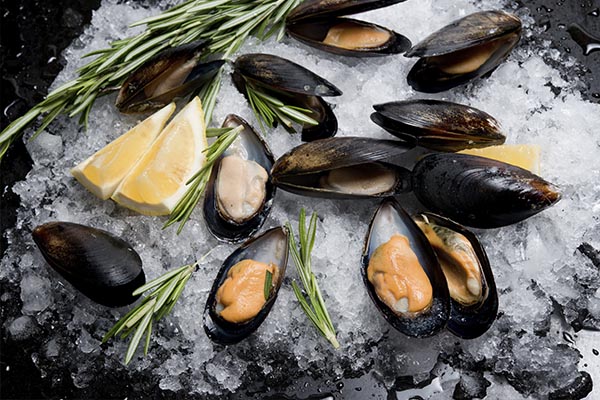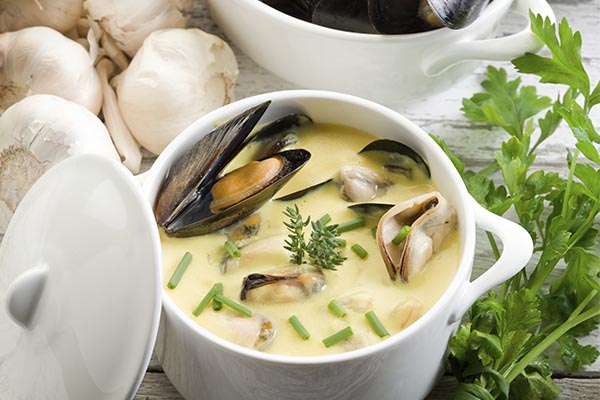The benefits of mussels for your health
The mussel is part of the bivalve family, that is, they have two shells. They are marine filter feeders that live under the water. The internal mass tends to be a pale orange colour if they are male, and a more intense orange if they are female.
fresh food
Share

The mussels for sale in Spanish markets come from national aquaculture, which means they can be eaten practically throughout the year at a good price. The mussel is the best-known and most popular mollusc from our country. The largest production takes place in the Rías Gallegas, although you can also find them being produced in the Mediterranean.
Within the Spanish market there are also mussels grown in other countries from around the world, such as Portugal and New Zealand. Of national origin, we can distinguish:
Mejillones de origen nacional
Mejillón gallego (Galician mussels)
Soft and juicy, yellow or reddish in colour, but more intense in the females than the males. This is the best-known mollusc in our country. The greatest production takes place in the Rías Gallegas. Practically the whole harvest is carried out with a system of troughs, floating platforms which are fixed to the sea floor from which ropes with netting are suspended on which the spawn or seed of the mussel attaches. After a short time, these nets dissolve leaving the mussels free to fix themselves onto the rope with their newly-developed byssal threads. The mussels are moved from one rope to another in order to distribute the weight (a process known as thinning out). They reach a commercially viable size in approximately one year.
Clóchina de Valencia (Mediterranean mussel)
Is cultivated in the ports of Valencia and Sagunto. It is of a smaller size than the Galician mussel, it is softer in taste and has much more flavour. Its season is from April to the end of August.
Mejillón del Delta del Ebro (Delta del Ebro mussel)
Its main characteristic is that it is grown in thewaters of the River Ebro estuary. They are well-known for their exquisite meat,which is of a hard consistency.

Nutritional value
In respect to its nutritional composition, the mussel has a low fat content and a high content in proteins of a high biological value, such as Omega 3, which is beneficial for the heart. It is also a food source rich in vitamins B12, B2 and B9 as well as a natural source of mineral salts such as iron, phosphorus, selenium, iodine, potassium and zinc. It has a low calorific value, for example, a 100 grams portion of mussels has 67 kcal.
The benefits of mussels
- They are a source of iodine, a mineral which contributes to normal cognitive function as well as the energy metabolism, the normal functioning of the nervous system and maintaining the skin in good condition.
- The large quantity of vitamin B12 in mussels contributes to the formation of red blood cells, the adequate functioning of the immune system, as well as reducing tiredness and fatigue.
- Mussels also have high levels of iron, which makes them suitable for persons suffering from anaemia.
- One of the mussel’s most important nutritional contribution is the fatty acid Omega-3, which has cardio-protective properties and regulates triglyceride and cholesterol levels.
- In addition, mussels are low in calories, making them suitable for slimming diets.

Advice on buying, storing and preparing
When buying mussels, pay special attention to their freshness, as it is a product that must be cooked while they are still alive. When choosing mussels check that the shell is not broken. If the shell is open it does not mean that the product is in poor condition, so long as it closes when you tap it.
Ideally, eat your mussels on the day you buy them or the following day. To store them, wrap them in a damp cloth and place them in the least cold part of the fridge. Never leave them outside the fridge, nor place them in the coldest part of the fridge. Never freeze them raw, as they will die. If you want to store them for longer than one day or freeze them, you will need to cook them first.
As mussels live attached to rocks, it is important to clean them well before cooking them, removing the filaments with a knife and scraping the shell with a brush or knife under the tap. In the supermarket, you will find ready-washed mussels ready to eat. There is a large number of traditional recipes for their preparation: “tigres”, a la marinera, or simply steamed with a sprinkling of pepper, bay leaf, garlic and lemon.
From our website to your kitchen
Steamed mussels or Mediterranean mussels
Mussel kebabs
Cream of mussels
Mussels with salsa verde






